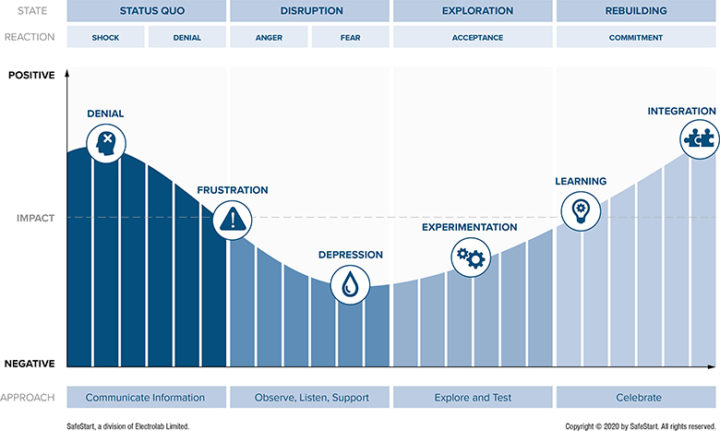Change is a challenge for many organizations, especially when it involves multiple people and, sometimes, multiple locations. And whether they want to implement small or large changes, as they decide on the best change management model for them, it’s easy to get lost in the structure and design of the plan and forget about the people it affects.
Before implementing any change initiative, organizations should consider the human aspect of it and, in particular, the issue of overcoming resistance. Change can be scary, and it’s natural for people to instinctively react in ways that are sometimes counterproductive or detrimental to the goal. It’s important for leaders to know what to expect and how to approach the emotional impact of organizational change.
The change curve
The easiest way to start is to consider the change curve, which illustrates how change affects people and organizations on an emotional level. This model is used widely in business and although there are different variations of it, they all aim to help organizations understand the different stages that individuals go through when change is being implemented.

Stage 1 – Shock or denial
There is a disruption to the status quo. People may be surprised by the change or they may not think that the change is needed. Some may also think that it’s just not going to happen. Because employees are preoccupied or worried about what’s going on, their productivity may drop. Leaders should make sure that people are not overwhelmed, they can see the direction the company is taking and they recognize how it’s going to benefit them personally.
Stage 2 – Anger or fear
At this stage, people understand what the change is or that it’s definitely happening, even though they may not want it. Employees could be upset that it’s being implemented or afraid of what the change might mean in the future. In general, people don’t like change because of the uncertainty. This is a risky time for the organization because people could get angry or actively work against the change. Productivity could fall even further, so leaders need to remain vigilant and thoughtful as they manage employees through this difficult time.
To make this transition easier, it’s vital for those in charge to truly listen to and consider people’s objections. Their comments may point out issues that were initially overlooked by the leadership, and management should embrace this opportunity to get some constructive feedback that can be used to minimize disruptions and increase employee engagement.
Stage 3 – Acceptance
Employees come to terms with the fact that a change is happening and want to explore the possibilities it presents. People may not agree with the change initiative but they realize that it’s not going away and they adapt. At this stage, productivity can rise. People also tend to become more optimistic and less fearful. With help, support and as much training as possible, employees will become more accepting and even start thinking that the change is necessary.
Stage 4 – Commitment
Employees have grown to accept or even embrace the change, learning to permanently integrate the changes into their work. At this stage, productivity should be better than it was before the change. Even if there is still some way to go, this is the time to make sure people are happy and comfortable with the new norm.
Considering how people react to change and planning for their emotional needs ahead of time can help organizations predict and successfully deal with delicate and challenging issues in a timely manner. Whether they’re already on board or still resisting change, employees need their leaders to support, educate and lead them towards the new status quo in a respectful and understanding manner.
Overcoming resistance
Before trying to carry out any change, leaders must recognize that resistance is normal, especially when people don’t understand the change, trust leadership, or believe the new initiative is necessary. In some cases, employees might think that a different change is needed or they’ve become cynical after a few failed change projects. They may think that this is just another flavor of the month initiative that will fizzle out soon enough. Some people can also have low tolerance for change in general.
The first thing to remember is that a supportive workplace culture, clear and inclusive communication, and reliable feedback loops as part of an organizational framework can be a huge help to any change management initiative. Experts know this too, which is why the recommended approaches to handling resistance always stress the importance of communication and employee involvement.
Six change approaches
Kotter and Schlesinger suggested Six Change Approaches to handle resistance to change:
1. Education and communication
First and foremost, employees need to understand the reasons for the change initiative. It’s important for people to see the leaders’ logic and hear the rationale, even if they don’t agree with it. And this should be done before any steps towards the change are taken. To help employees really understand the reasons behind the change, leaders should use a range of techniques and multiple meetings to hammer home the message. This is especially true if they know there’s a lack of knowledge on the subject or that inaccurate information is being circulated.
2. Participation and involvement
When building a change management team, it’s important to gather input from all levels and departments of the organization. Having people involved in the process helps them engage in (or at least tolerate) the change in a positive way. If people are given a chance to come up with ideas, discuss the ideas of others, or otherwise be involved in the process, they’ll become invested in the change and understand it better.
When it’s clear that certain individuals are more likely to resist the change, leaders should make sure to include them in the design aspect of the plan. They will then have ownership of it and they’ll feel more involved, leading to commitment, which is worth much more than meek compliance. This approach is most useful when leaders don’t yet have all the necessary information to plan the change and where there is a chance that employees will have the power to resist.
3. Facilitation and support
Leaders need to invest a little more time to provide facilitation and support when people are resistant due to fear and anxiety. Training alone is not enough. Leaders should think about guided discussion groups to help people talk about their worries or even vent their frustrations. In anxiety-inducing situations, the change curve can help leaders understand what kind of support is needed at each stage.
4. Negotiation and agreement
When individuals or groups value logic and stability, and think they’d be worse off because of the change, leaders need to take an approach that is fair, logical and consistent. Employees have to see clearly that the change—whether they agree with it or not—is being introduced and implemented in a way that makes sense. For example, if an action needs to be performed, leadership should communicate the reasons behind it and the outcomes that are expected. This will ensure that employees will see why certain choices are being made and provide the much-needed stability.
5. Manipulation and co-optation
In order to encourage change-resistant people to adjust their position, information must be used in a selective way. Leaders need to determine which employees are happy with the prospect of change and appoint them as “change agents”. Their mission will be to sell the change to others in the organization, so leaders must choose their agents wisely. For individual employees or well-respected group leaders, this could mean including them in the change management team.
This approach can be a bit of an ethical dilemma, but it’s often the only option left when all others have failed. If it’s done incorrectly, and people realize that they are being manipulated, it can intensify resistance and lead to more problems.
6. Explicit and implicit coercion
If there’s absolutely no willingness from people to accept and participate in the change, leaders could consider communicating potential negative consequences of continuing the status quo. This approach should be the absolute last resort, only to be used if all else fails.
Lewin’s Force Field Analysis
Overcoming resistance isn’t easy, and apart from honing soft skills and learning about the change curve and the different change approaches, some organizations might find it useful to also consider Lewin’s Force Field Analysis to see what makes their status quo stable. This would help them figure out how to destabilize it, introduce the new initiative and overcome employee resistance.
According to Lewin, organizational culture is an equilibrium between two forces: one favorable to change and one opposing it. Organizations that hope to introduce change need to know exactly which forces are in their workplace—these involve values, attitudes and experiences of individuals and groups. If leaders have the required awareness and emotional intelligence, they will be able to use their knowledge of the existing forces in their organization to change the equilibrium by reducing resisting forces or adding favorable ones.
In general, the idea is to list the forces present in the status quo and then rate their importance and urgency by assigning them a numerical value. The cumulative value of the forces on both sides of the status quo can help leaders determine which forces are stronger, and whether change is viable at this time.
The common criticism of this method focuses on the subjectivity of the numerical scores attributed to the forces present. Whether this analysis is useful depends on the organization, but it can be a useful tool for companies that value self-awareness and soft skills that allow them to know exactly where their employees are emotionally and culturally.
People and change
It’s important to remember that getting buy-in or acceptance of a change initiative is not the end of the initiative. Employees still need to develop new habits that are required within the newly changed environment, and learning new habits can be tricky, so organizational support will be required.
For example, a new safety initiative may be accepted by employees, but if a change of behavior is required, leaders should remember that developing new habits takes time, conscious effort and encouragement. Having a strong culture with a great framework of communication and reliable feedback loops is the basis on which successful change can happen and new habits can be developed.
Change is never easy. And whatever the company is struggling with—safety, training, structure or communication—considering the human aspect of change is a critical (and sometimes the most unpredictable) part of any management plan. Organizations must always keep in mind that it’s people who will be implementing and living the change.

